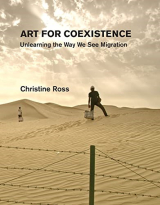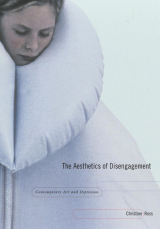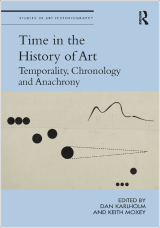
Christine Ross is Distinguished James McGill Professor in Contemporary Art History in the Department of Art History and Communication Studies at McGill University. Her areas of research include contemporary media arts; vision and visuality; transformations of spectatorship in contemporary art; participatory media and art; artistic redefinitions of the public sphere; the reconfigurations of time and temporality in contemporary media art practices; and contemporary art’s response to migration.
 Her books include: Art for Coexistence: Unlearning the Way We See Migration (MIT Press, 2022);The Past is the Present; It’s the Future too: The Temporal Turn in Contemporary Art (Continuum, 2012); The Aesthetics of Disengagement: Contemporary Art and Depression (University of Minnesota Press, 2006); and Images de surface: l’art vidéo reconsidéré (Artextes, 1996). She has coedited The Participatory Condition in the Digital Age (University of Minnesota Press, 2016) with Darin Barney, Gabriella Coleman, Jonathan Sterne and Tamar Tembeck; Conflict[ed] Reporting: War and Photojournalism in the Digital Age [special issue of Photography & Culture, 8 (2), November 2015] with Tamar Tembeck and Theodora Tsentas; and Precarious Visualities: New Perspectives on Identification in Contemporary Art and Visual Culture (McGill-Queen’s University Press, 2008) with Olivier Asselin and Johanne Lamoureux. She is currently working on a book project, entitled Coexistence: Contemporary Art in the Age of the Migrant Crisis.
Her books include: Art for Coexistence: Unlearning the Way We See Migration (MIT Press, 2022);The Past is the Present; It’s the Future too: The Temporal Turn in Contemporary Art (Continuum, 2012); The Aesthetics of Disengagement: Contemporary Art and Depression (University of Minnesota Press, 2006); and Images de surface: l’art vidéo reconsidéré (Artextes, 1996). She has coedited The Participatory Condition in the Digital Age (University of Minnesota Press, 2016) with Darin Barney, Gabriella Coleman, Jonathan Sterne and Tamar Tembeck; Conflict[ed] Reporting: War and Photojournalism in the Digital Age [special issue of Photography & Culture, 8 (2), November 2015] with Tamar Tembeck and Theodora Tsentas; and Precarious Visualities: New Perspectives on Identification in Contemporary Art and Visual Culture (McGill-Queen’s University Press, 2008) with Olivier Asselin and Johanne Lamoureux. She is currently working on a book project, entitled Coexistence: Contemporary Art in the Age of the Migrant Crisis.

Between 2005 and 2018, she was the principal investigator of the FQRSC-funded MediaTopia team research projects, including: Aesthetics, New Media and the (Re)Configuration of the Public Sphere (2013-2017), Art and New Media: Towards a Hybrid Redefinition of Site (2009-2013) and Augmented Reality in Contemporary Art: Interdisciplinary Practices (2005-2009). From 2012 to 2017, she was the Director of Media@McGill—a hub of interdisciplinary research, scholarship, and public outreach on issues in media, technology and culture. Elected Member of the Royal Society of Canada (2010-), first laureate of the Artexte Canadian Award for Research in Contemporary Art (2012), recipient of the David Thomson Award for Graduate Supervision and Teaching (2011), recipient of the Prix Recherche de l’Observatoire du cinéma au Québec (2016), Distinguished Visiting Fellow at the Jackman Humanities Institute, University of Toronto (2017), she is the cofounder (with Professor Will Straw) of the Department of Art History and Communication Studies at McGill University.
 Other publications include: “Postmodern Art/Aesthetics,” in Vattimo, ed. Simonetta Moro (Edinburgh: Edinburgh University Press, forthcoming 2023); “Isuma, the Planetary, Listening and the Reinvention of the Counterpublic Sphere,” in FABRICATING PUBLICS: The Dissemination of Culture in the Post-Truth Era, ed. Bill Balaskas and Carolina Rito (Open University Press, 2021); “The Transparent Society: Is the Liberation of Differences still what the 21st Century Needs?,” Journal of Italian Philosophy 4 (2021); “Le postmodernisme, autour de trois écrits,” in L’illusion postmoderne?, ed. Chantal Boulanger, Nicolas Mavrikakis and Laurent Vernet (Montreal: Nota Bene Varia 2021); “The Aesthetics of Coexistence as Ongoing,” in Aesthetic Temporalities Today: Present, Presentness, Re-Presentation, ed. Gabriele Genge, Ludger Schwarte, and Angela Stercken (Berlin: Verlag, 2020); “Temporalizing the Aesthetics of Coexistence: The Present as Ongoing,” Ästhetische Eigenzeiten 10 [special journal issue, Aesthetic Temporalities Today: Present, Presentness, Presentation] (forthcoming 2020); “The Aesthetics of Stillness, after Film,” in The Aesthetics of Standstill, ed. Reinhold Görling, Barbara Gronau and Ludger Schwarte (Berlin: Sternberg Press, 2019); “Sarah Sze’s The Last Garden and the Temporality of Wonder:” in Time in the History of Art: Temporality, Chronology, and Anachrony, ed. Dan Karlholm and Keith Fleming Moxey (New York: Routledge, 2018); “‘Not Directed Toward Anyone’: The Indifference of a Situation or, Perception under Influence” in Perception and Agency in Shared Spaces of Contemporary Art, ed. Cristina Albu and Dawna Schuld (New York: Routledge, 2017); “The Performance-Management Model of Performative Subjectivity,” in Boredom, ed. Tom McDonough (London and Cambridge, MA: Whitechapel Gallery and MIT Press, Documents of Contemporary Art series, 2017); “La suspension de la historia en el media art contemporaneo,” and “The Suspension of History in Contemporary Media Arts,” Contranarrativas(0), 2017; “An Aesthetics of Inhabitability,” in Mark Lewis Filmworks, eds. Hamid Taieb and François Bovier (Geneva: MetisPresses, 2016); “The Spreadability of Video,” in Abstraction in Video, ed. Gabrielle Jennings (University of California Press, 2015); “Toucher l’autre: une histoire de surfaces corpo-électroniques,” in Mona Hatoum, ed. Christine Van Assche (Paris: Centre Pompidou, 2015); “The Cloud in Video: Notes on Isabelle Hayeur’s Aftermaths,” Espace, 2015; “Depression,” in Encyclopedia of Aesthetics (Oxford University Press), 2014; “The Movement of the Image. Vitality in Olivia Boudreau’s Media Production” in L’oscillation du visible. Olivia Boudreau, ed. Michèle
Other publications include: “Postmodern Art/Aesthetics,” in Vattimo, ed. Simonetta Moro (Edinburgh: Edinburgh University Press, forthcoming 2023); “Isuma, the Planetary, Listening and the Reinvention of the Counterpublic Sphere,” in FABRICATING PUBLICS: The Dissemination of Culture in the Post-Truth Era, ed. Bill Balaskas and Carolina Rito (Open University Press, 2021); “The Transparent Society: Is the Liberation of Differences still what the 21st Century Needs?,” Journal of Italian Philosophy 4 (2021); “Le postmodernisme, autour de trois écrits,” in L’illusion postmoderne?, ed. Chantal Boulanger, Nicolas Mavrikakis and Laurent Vernet (Montreal: Nota Bene Varia 2021); “The Aesthetics of Coexistence as Ongoing,” in Aesthetic Temporalities Today: Present, Presentness, Re-Presentation, ed. Gabriele Genge, Ludger Schwarte, and Angela Stercken (Berlin: Verlag, 2020); “Temporalizing the Aesthetics of Coexistence: The Present as Ongoing,” Ästhetische Eigenzeiten 10 [special journal issue, Aesthetic Temporalities Today: Present, Presentness, Presentation] (forthcoming 2020); “The Aesthetics of Stillness, after Film,” in The Aesthetics of Standstill, ed. Reinhold Görling, Barbara Gronau and Ludger Schwarte (Berlin: Sternberg Press, 2019); “Sarah Sze’s The Last Garden and the Temporality of Wonder:” in Time in the History of Art: Temporality, Chronology, and Anachrony, ed. Dan Karlholm and Keith Fleming Moxey (New York: Routledge, 2018); “‘Not Directed Toward Anyone’: The Indifference of a Situation or, Perception under Influence” in Perception and Agency in Shared Spaces of Contemporary Art, ed. Cristina Albu and Dawna Schuld (New York: Routledge, 2017); “The Performance-Management Model of Performative Subjectivity,” in Boredom, ed. Tom McDonough (London and Cambridge, MA: Whitechapel Gallery and MIT Press, Documents of Contemporary Art series, 2017); “La suspension de la historia en el media art contemporaneo,” and “The Suspension of History in Contemporary Media Arts,” Contranarrativas(0), 2017; “An Aesthetics of Inhabitability,” in Mark Lewis Filmworks, eds. Hamid Taieb and François Bovier (Geneva: MetisPresses, 2016); “The Spreadability of Video,” in Abstraction in Video, ed. Gabrielle Jennings (University of California Press, 2015); “Toucher l’autre: une histoire de surfaces corpo-électroniques,” in Mona Hatoum, ed. Christine Van Assche (Paris: Centre Pompidou, 2015); “The Cloud in Video: Notes on Isabelle Hayeur’s Aftermaths,” Espace, 2015; “Depression,” in Encyclopedia of Aesthetics (Oxford University Press), 2014; “The Movement of the Image. Vitality in Olivia Boudreau’s Media Production” in L’oscillation du visible. Olivia Boudreau, ed. Michèle  Thériault (Montreal: Leonard & Bina Ellen Art Gallery, 2014); “Movement That Matters Historically: Janet Cardiff and George Bures Miller’s 2012 Alter Bahnhof Video Walk,” Discourse: Journal for Theoretical Studies in Media and Culture[special journal issue: Moving (with) Images: Gender, Affect, and the Senses, eds. Martha Zarzycka and Bettina Papenburg] Spring 2013/Spring 2014; “Historical Time Ecologized,” Esse, 2014; “Après la vidéo,” Revue 24 Images, 2014; “The Affective Historicization of Public Spaces,” Ciel Variable, 2013; “La réalité augmentée en art: une question de (non)destination,” in Le Réel à l’épreuve des technologies: les arts de la scène et les arts médiatiques, eds. Josette Féral and Edwige Perrot (Presses Universitaires de Rennes, 2013); “Historical Narrative in the Work of Stan Douglas,” in L’Art de la syntaxe, ed. J. Game, (Paris: Éditions de Vincennes, 2011); “New Screens Beyond the Screen: The Spatial Distribution of the Image in Augmented Reality Art,” in Screen/Space: The Projected Image in Contemporary Art, ed. T. Trodd (Manchester: Manchester University Press, 2011); “Spatial Poetics: The (Non)Destinations of Augmented Reality Art, Part I” and “Spatial Poetics: The (Non)Destinations of Augmented Reality Art, Part II” (Afterimage, 2010); “Video Art in Canada,” in Canadian Art: The Twentieth Century , eds. B. Foss, S. Pakowsky, and A. Whitelaw (Oxford University Press, 2010); “The Suspension of History in Contemporary Media Arts,” (Intermédialités, 2009); “New Media’s Presentness and the Questioning of History: Craigie Horsfield’s Broadway Installation,” (Cinémas, 2007); “The temporalities of video: extendedness revisited” (Art Journal, 2006); “New media art hybridity and augmented reality: a process for the interaction of art, (neuro)science and AR technology” (Convergence, 2005); “The Paradoxical Bodies of Contemporary Art,” in Contemporary Art, ed. A.
Thériault (Montreal: Leonard & Bina Ellen Art Gallery, 2014); “Movement That Matters Historically: Janet Cardiff and George Bures Miller’s 2012 Alter Bahnhof Video Walk,” Discourse: Journal for Theoretical Studies in Media and Culture[special journal issue: Moving (with) Images: Gender, Affect, and the Senses, eds. Martha Zarzycka and Bettina Papenburg] Spring 2013/Spring 2014; “Historical Time Ecologized,” Esse, 2014; “Après la vidéo,” Revue 24 Images, 2014; “The Affective Historicization of Public Spaces,” Ciel Variable, 2013; “La réalité augmentée en art: une question de (non)destination,” in Le Réel à l’épreuve des technologies: les arts de la scène et les arts médiatiques, eds. Josette Féral and Edwige Perrot (Presses Universitaires de Rennes, 2013); “Historical Narrative in the Work of Stan Douglas,” in L’Art de la syntaxe, ed. J. Game, (Paris: Éditions de Vincennes, 2011); “New Screens Beyond the Screen: The Spatial Distribution of the Image in Augmented Reality Art,” in Screen/Space: The Projected Image in Contemporary Art, ed. T. Trodd (Manchester: Manchester University Press, 2011); “Spatial Poetics: The (Non)Destinations of Augmented Reality Art, Part I” and “Spatial Poetics: The (Non)Destinations of Augmented Reality Art, Part II” (Afterimage, 2010); “Video Art in Canada,” in Canadian Art: The Twentieth Century , eds. B. Foss, S. Pakowsky, and A. Whitelaw (Oxford University Press, 2010); “The Suspension of History in Contemporary Media Arts,” (Intermédialités, 2009); “New Media’s Presentness and the Questioning of History: Craigie Horsfield’s Broadway Installation,” (Cinémas, 2007); “The temporalities of video: extendedness revisited” (Art Journal, 2006); “New media art hybridity and augmented reality: a process for the interaction of art, (neuro)science and AR technology” (Convergence, 2005); “The Paradoxical Bodies of Contemporary Art,” in Contemporary Art, ed. A.  Jones (Blackwell, 2006); “The Disappearing Screen: An Incomplete Matter” (Parachute, 2004); “Redefinitions of abjection in contemporary performances of the female body,” in Grotesque Histories of Modern Art, ed. F. Connelly (Cambridge University Press, 2003); “To Touch the Other: A Story of Corpo-Electronic Surfaces,” in The Feminism and Visual Cultural Reader, ed. A. Jones (Routledge, 2003); “Pipilotti Rist: Images as Quasi Objects” (n. paradoxa 7, 2001); “The Insufficiency of the Performative: Video art at the turn of the millennium” (Art Journal, 2001); and “Vision and insufficiency…: Rosemarie Trockel’s Distracted Eye” (October, 2001).
Jones (Blackwell, 2006); “The Disappearing Screen: An Incomplete Matter” (Parachute, 2004); “Redefinitions of abjection in contemporary performances of the female body,” in Grotesque Histories of Modern Art, ed. F. Connelly (Cambridge University Press, 2003); “To Touch the Other: A Story of Corpo-Electronic Surfaces,” in The Feminism and Visual Cultural Reader, ed. A. Jones (Routledge, 2003); “Pipilotti Rist: Images as Quasi Objects” (n. paradoxa 7, 2001); “The Insufficiency of the Performative: Video art at the turn of the millennium” (Art Journal, 2001); and “Vision and insufficiency…: Rosemarie Trockel’s Distracted Eye” (October, 2001).